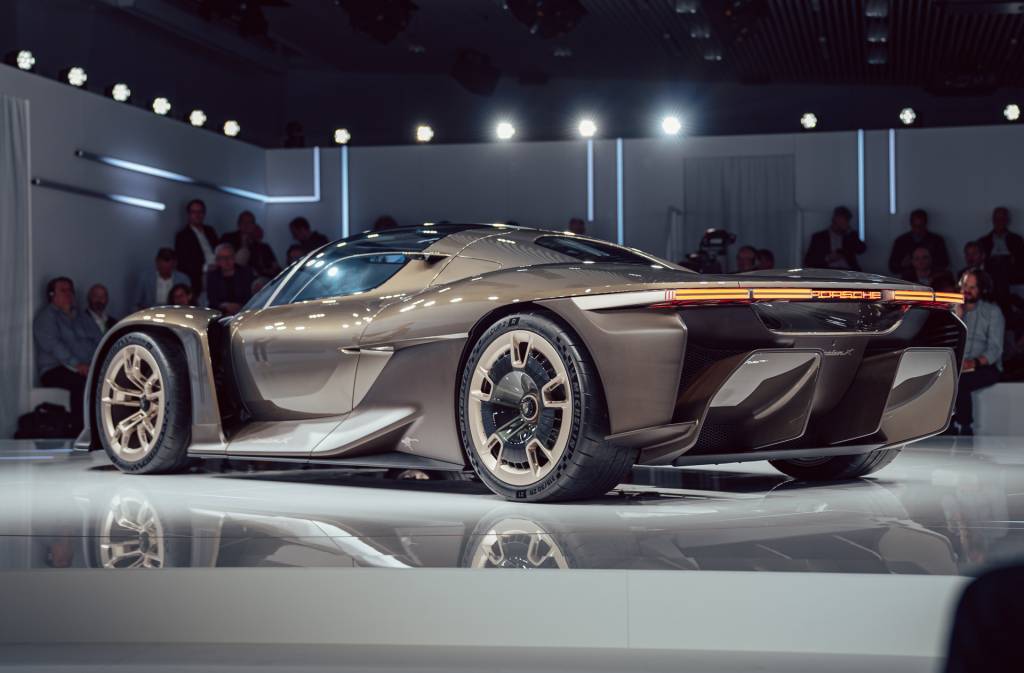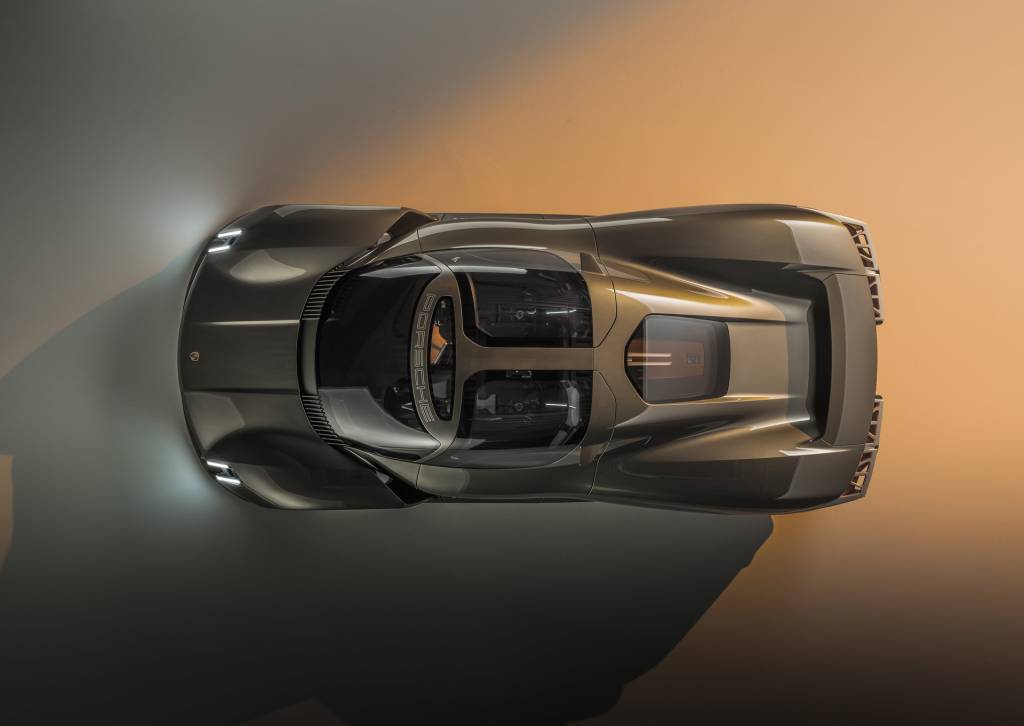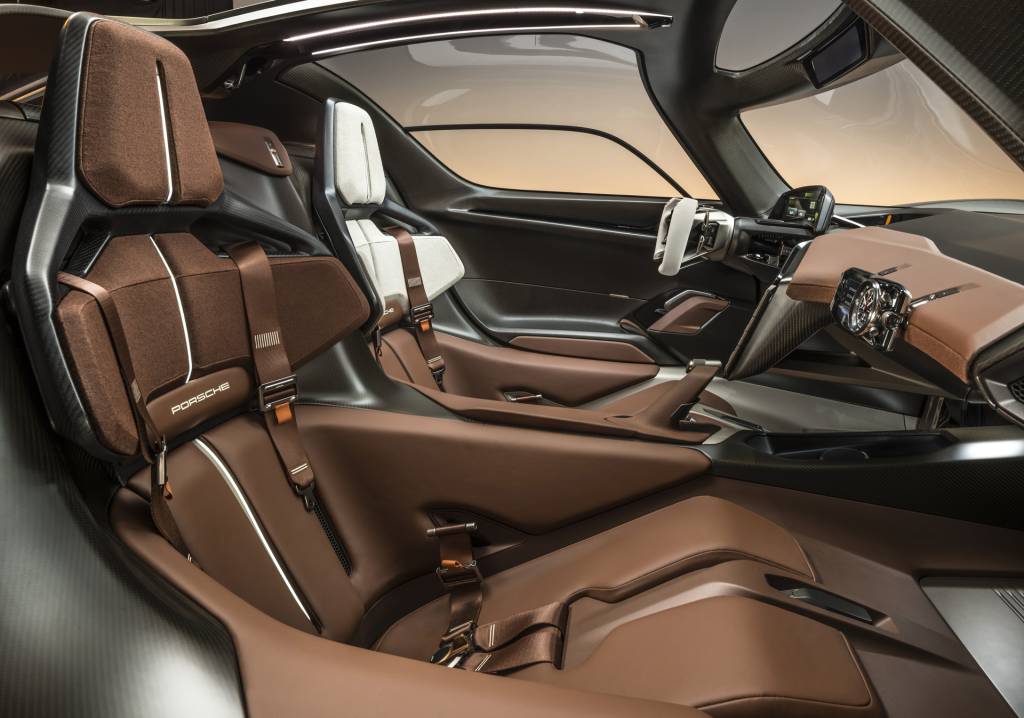Every decade or so, Porsche goes beyond its sports cars to build a supercar. The last one was the 918 Spyder of 2013-2015 that was the German brand’s first plug-in hybrid. Now, Porsche is considering a plug for its next supercar, though this one would forego any internal-combustion engine and would be a battery-electric vehicle.
It debuted last week in concept form as the Porsche Mission X, and its design incorporates elements inspired by motorsports, luxury cars, traditional Porsches, and automotive innovation.
The car’s form factor is that of a mid-engine supercar. That gives the car a short nose, a cabin that’s pushed forward like in the C8 Chevrolet Corvette and Audi R8, and a long tail. In a design call with automotive media, Peter Varga, director exterior design at Porsche, said the battery is located behind the passenger seat of the two-seater, presumably next to the power electronics and/or an electric motor.
Notably, the look differs from the 911, elements of which are used in all Porsche mainline cars.
Porsche Mission X concept

Porsche Mission X concept

Porsche Mission X concept
The Mission X takes on a new face with vertical headlights that feature four distinct LED light bars. Each headlight unit has a structural webbing that is found in other places throughout the car’s design. The lower portion of the nose is a full-width air intake that provides both aerodynamic and cooling functions. Most EVs have closed-off faces, but the open lower fascia of the Mission X demonstrates its performance intent. In total, the nose looks very short, almost stubby.
The hood rakes down from the cabin to sit low up front, which should provide great forward sight lines. It also has a depressed center section and air vents at its rear edge. Varga said there is no frunk below the hood, but that’s likely because this is a concept car. Expect a frunk in any possible production version.
The front fenders have a pontoon look, especially when viewed from the rear, where they open up and you can see the body taper inward. However, the rear of that pontoon is flat for better airflow off the tires. The doors sit a few inches inboard, a design element Varga says was inspired by the look of the Carrera GT of 2004-2006 and the 918 Spyder. Lower side skirts with the “Mission X” script rise up to end in the rear fenders.
The roof has a definite influence from Porsche’s 906, 907, 908, and 917 race cars of the 1960s and ’70s. It highlights both the exterior and interior as it brings the glass all the way to the top of the car, only leaving a structural spine. The doors open scissors-style, like on a Lamborghini. An oval window that Porsche calls a Daytona window sits at the top of the windshield. There are no side mirrors. Instead, the Mission X has airplane-style shark fins behind the doors that house rearview cameras.
The rear fenders have an envelope design instead of the pontoon look of the fronts, and the rear hatch has a window for a rearward view and possibly to see elements of the electric powertrain.
At the rear, the Mission X sports a horizontal theme rather than a vertical theme like up front. A taillight bar spans the width of the car, interrupted in the center by lighted “Porsche” lettering. Like the headlights, the LED taillights also sit in a webbed structure, elements of which are also found in the wheel design. A large diffuser channels the air off the rear of the car.
Porsche hasn’t stated a coefficient of drag for the Mission X, but it did say the car can create more downforce than the 2023 911 GT3 RS, which maxes out at a whopping 1,895 pounds of downforce at 177 mph.

Porsche Mission X concept
Inside, the Mission X combines race car and luxury elements. The steering yoke incorporates several controls like modern race cars. They include controls for the drive modes, stability control, corner vectoring, braking balance, energy recuperation, as well as the turn signals. A low-profile digital instrument cluster sits on the steering column to move with the steering wheel, and the pedals are adjustable. The start switch, in typical Porsche fashion, is located to the left of the steering yoke.
Occupants will have to step over thick carbon-fiber sills (which are part of the chassis and clear-coated in black) to access the different color seats for the driver and passenger. The seats are made of pads. Markus Auerbach, director interior design at Porsche, says the pads are removable to allow custom pads to be 3D-printed based on scans of the driver’s (and presumably passenger’s) body.
A portrait-style center screen would have reduced media content versus today’s luxury cars as the Mission X’s mission is driving. Porsche even provides large buttons along the right side of the screen to make the screen easier to use with driving gloves.
Below the screen is a gearshift lever that can also serve as a handrest to use the touchscreen, while the passenger side of the dash gets a timer unit with a digital component and a large analog clock. We take that as the logical evolution of Porsche’s Sport Chrono package. It can display track times and health information on the driver, and its screen is removable. Cameras in the doors can also record video inside and outside the vehicle, and those feeds can be edited to provide a recap of a driving session.
The door panels are home to air vents that won’t fit on the dash, as well as display screens that show the view of the exterior camera mirrors. A rear camera mirror also sits up high, while the spine of the roof is home to lighting. The glove box also doesn’t fit on the dash and instead sits in the middle of the car between the seats.
After its debut last week, Porsche is collecting customer feedback and trying to create a business case for the Mission X. Should it get the green light, it would likely take about four years to hit the market.
